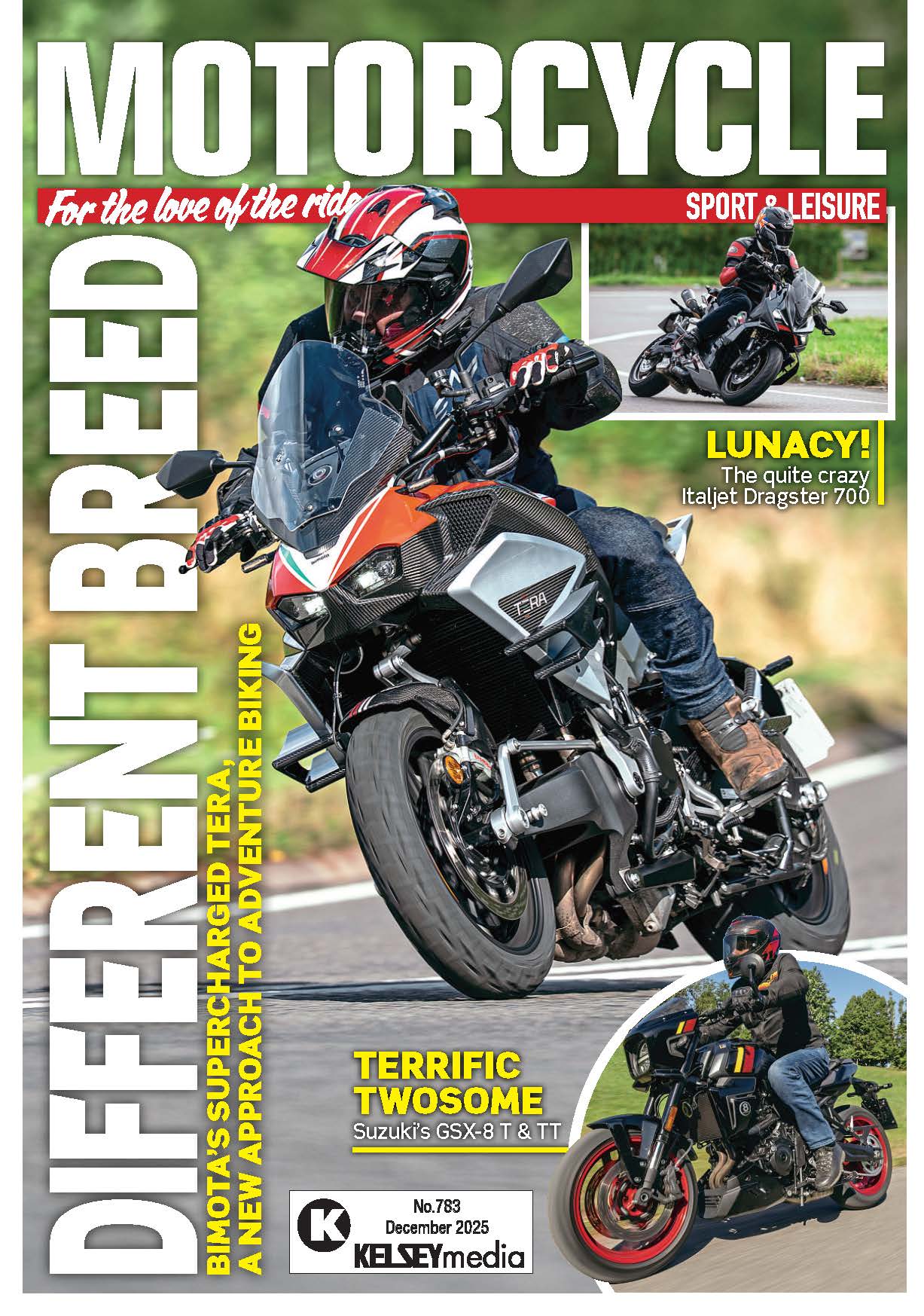There’s more choice than ever if you’re after an adventure bike that’ll dominate the roads. In an ever-crowded market, can the latest generation of Ducati’s pioneering Multistrada – with its Panigale-derived motor and raft of electronics – retain its reputation as one of the quickest, most surefooted and thrilling ways to cross continents?

WORDS: Ross Mowbray PHOTOGRAPHY: Gary Chapman
With well over 100,000 bikes sold worldwide in the 20-odd years since its introduction, the Multistrada is a very important motorcycle that’s come a long way since it first arrived on the scene in 2003.
Enjoy everything More Bikes by reading the MoreBikes monthly newspaper. Click here to subscribe, or Read FREE Online.
The motorcycling landscape was pretty different back then. Sportbikes and sport tourers were in vogue, and adventure bikes were by and large the preserve of proper explorers who wanted big-mile comfort and reasonable off-road performance.
So when Ducati launched its first generation Multistrada, it didn’t quite fit in. Despite its bold adventure-tourer-cum-sportbike package being formidable enough to impress, its 999-inspired looks proved a little too Marmite for many.
The Italian firm stuck at it though, and by the time 2010 rolled around things were markedly different. Adventure bikes were big business – and long travel suspension, wide bars and proper all-day comfort were the order of the day. There was room for variety, too; adventure didn’t just have to mean getting up on the pegs and exploring off-the-beaten-path. The Multistrada was starting to make sense.
The second generation, tech-laden 150bhp, 1198cc Testastretta V-twin-powered Multistrada 1200 had broader appeal. Sleeker, sharper and capable of delivering big smiles for riders after a long-legged adventure bike for the road (or even the racetrack). The factory had found a winning formula.
And they rolled with it; releasing a bunch of variants, adding semi-active suspension in 2013 and VVT in 2015, before eventually releasing the subtly-overhauled and improved Multistrada 1260 in 2018, powered by the 156bhp longer stroke motor from the X-Diavel. The 1260 is a bike I know well. I’ve ridden to Scotland on the S, tackled trails on the Enduro and spent a glorious couple of weeks restraining my inner hooligan on the Pikes Peak. I was (and am) a fan.
But not content to rest on its laurels, Ducati took to the drawing board and came up with something even more impressive for 2021 – taking the V4 motor from the Panigale; fitting a larger 19-inch front wheel (in place of the old 17-incher); adding radar-assisted cruise control up front; a blind spot detection radar at the back; and some seriously clever anti-weave control tech. And then in 2022, the factory made a few more tweaks, updating the electronic suspension, improving the infotainment system, and broadening the accessories catalogue.
And here we are in 2024, with a whopping six seriously sophisticated big Multistradas to choose from, to suit riders of all shapes, sizes and dispositions. There’s the standard V4, the V4S, the V4 S Grand Tour, the V4 Rally, the V4 Pikes Peak, and the V4 RS (and there’s the V2 and V2 S, too). We’ve never had so much choice.

To see what the latest generation’s really made of we swiped a V4S for a month in an attempt to get under its skin and find out whether it’s just as good carving corners throughout a dark, dismal British winter as it is being thrown around on the pristine, sticky Tarmac of its homeland.
The V4S sits just above the standard Multistrada V4 in Ducati’s ever-growing adventure bike range. At £20,495, it’s three-and-a-half grand more expensive than the standard £16,995 V4. While the two do share many of the same core features and parts, the additional cash gets you a full suite of rider aids (rather than just a few), better brakes, more sophisticated suspension, a bigger TFT dash, and the chance to access the clever radar technology.
The one we were testing also had a few additional goodies. In addition to the ‘Full’ pack which includes hard panniers, a centre stand, heated grips, a heated seat, the radar system, Akrapovic muffler and carbon front mudguard (and takes the price up to £24,345), we had some spoked wheels and the Iceberg White paint job (for an additional £1000). That takes the total cost up to a pretty hefty £25,345.
In the flesh, it looks every inch the premium motorcycle. It’s remarkably handsome, seriously well put-together, and dripping with top technology. You couldn’t, shouldn’t and wouldn’t expect anything else from a modern Ducati.
If you’ve seen or spent any time on the outgoing 1260, it will all look and feel very familiar. Yet, the V4 is a deceptively different proposition. The new 19-inch front wheel and lower redline help make that pretty clear right from the off.
The centrepiece of the bike is its Panigale-derived 1158cc V4 Granturismo motor. It’s been bored out from 1103cc to 1158cc and retuned to make 170bhp at 10,500rpm and 92lb-ft of torque at 8750rpm. It’s 1.5kg lighter than the old one, and it’s smaller, too. It’s a genuinely wonderful thing; remarkably smooth, incredibly flexible, and super-tractable from right down low in the revs. It sounds great, too, with a joyous bark emanating from the Akrapovic exhaust every time you crack the throttle.
With 170bhp to play with, it’s no slouch, and you’ll find yourself topping a ton in the blink of an eye. The incredibly slick quickshifter makes that all too easy. It’s one of the best systems I’ve ever used – properly light and seemingly infallible.
Thankfully, the abundant suite of electronics makes it relatively easy to either reign in or unleash the V4. Flicking through the multiple rider modes which adjust the engine mapping, power output, traction control settings, wheelie control level and electronic suspension set up, you can quickly and easily transform the bike from docile motorway cruiser to thrilling twisty-road weapon. They’re customisable, too, so you can finetune your preferences and create a rider mode that works for you and your riding style. It’s all pretty straightforward to navigate, too; a few taps on the easy-to-operate multi-switch controller and you’ll be away.

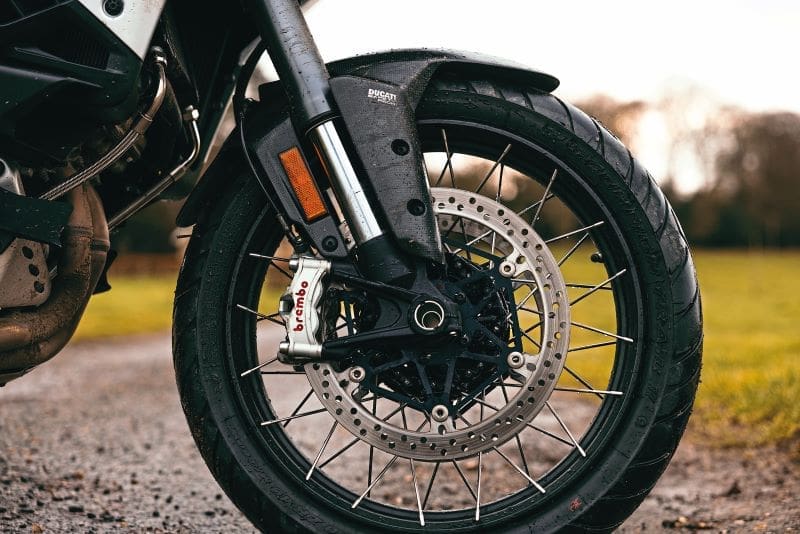
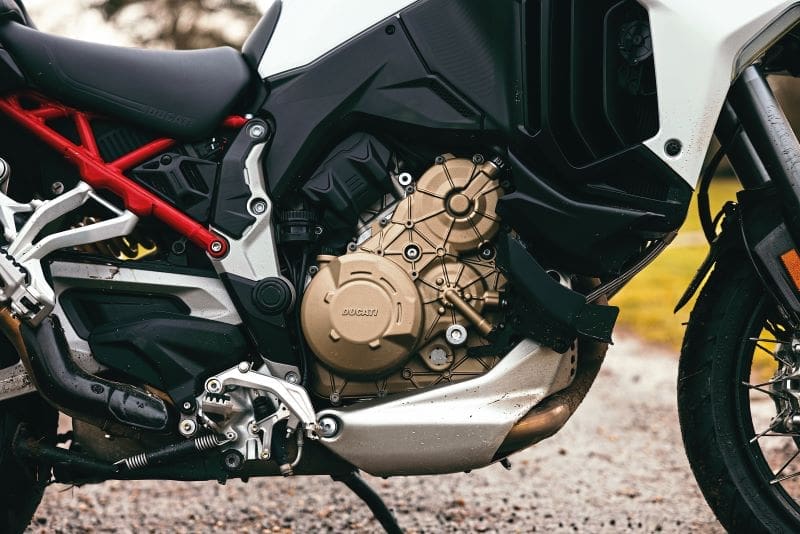
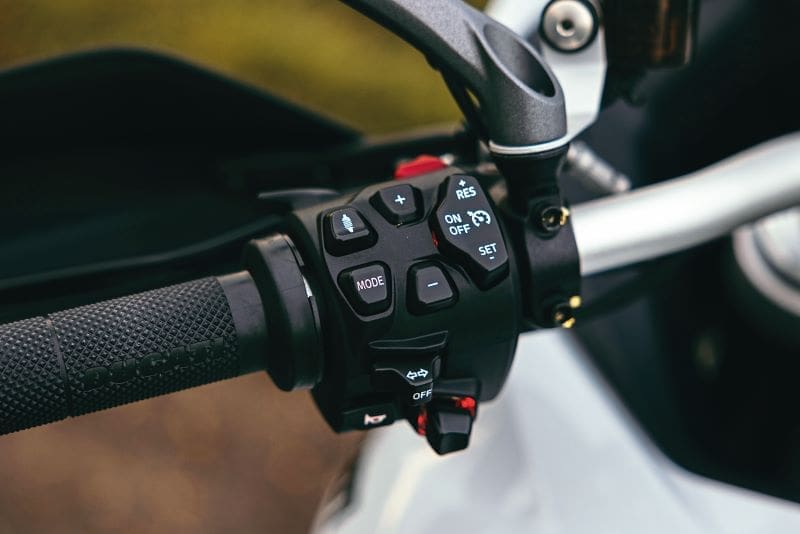
I found most of what I needed in either Sport or Touring. Sport does exactly what it says on the tin, firming up the suspension and sharpening the throttle response, to help transform the V4S into a seriously rapid road bike that’d likely hold its own with much more obviously ‘focused’ machines. Touring was a bit more forgiving; with a slightly less potent throttle response and plusher suspension, perfect for bounding across rough pothole-strewn roads and pottering through towns and villages.
The electronic goodies continue in the form of an endless array of rider aids to help keep you and the bike in check. It all works seamlessly, with no obvious interference – aside from one little reminder from the ABS to stay sensible on some grimy, wet, leaf-laden roads.
There’s adaptive cruise control, too. It’s an invaluable addition if you’re going to be doing big miles on motorways. Stick it on and the radar will work to keep a consistent distance between you and the vehicle in front. There’s a blind spot detector, too, which flashes a warning when vehicles are getting a little too close.
It stops plenty well. The Brembo Stylemas and touring-spec pads have a hard job on their hands hauling up the 231kg lump, but they manage the job well. There’s bags of engine braking, too. I know that’s not for everyone, but for the kind of nadgery back-lane on-off throttle riding I really enjoy, it’s just about perfect.
The handling’s excellent. It is a big bike and you know it when you’re throwing it around, but a lighter and stiffer monocoque frame coupled with the latest generation semi-active suspension means that the V4 somehow feels much more stable than the old 1260, despite the switch in front wheel size.
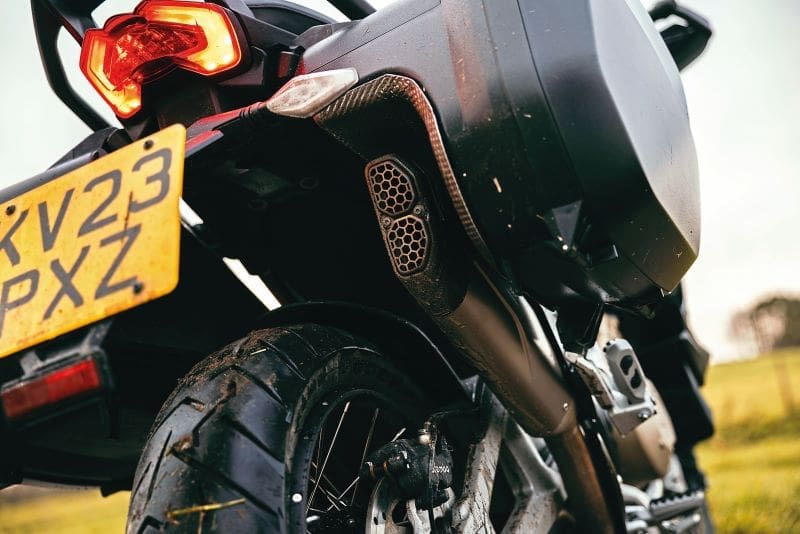
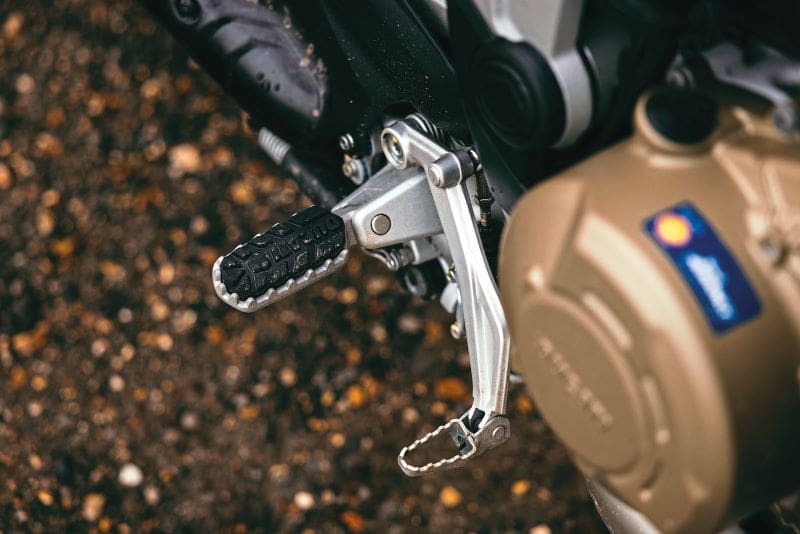
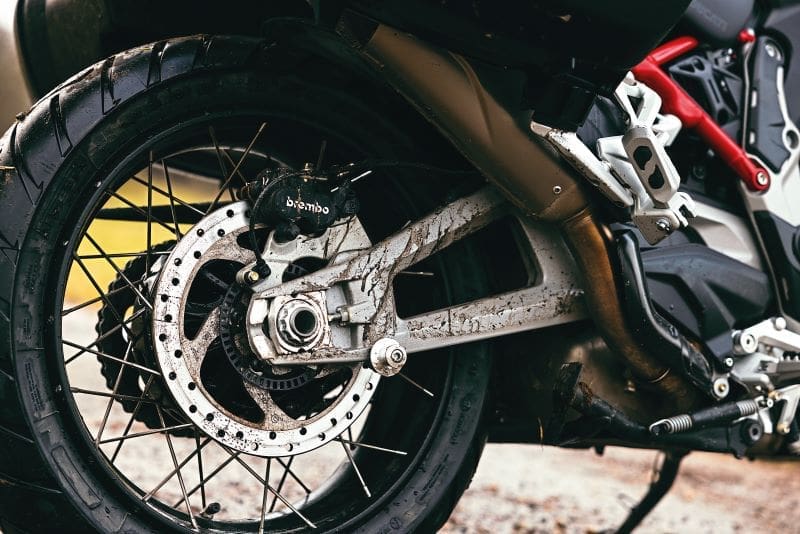
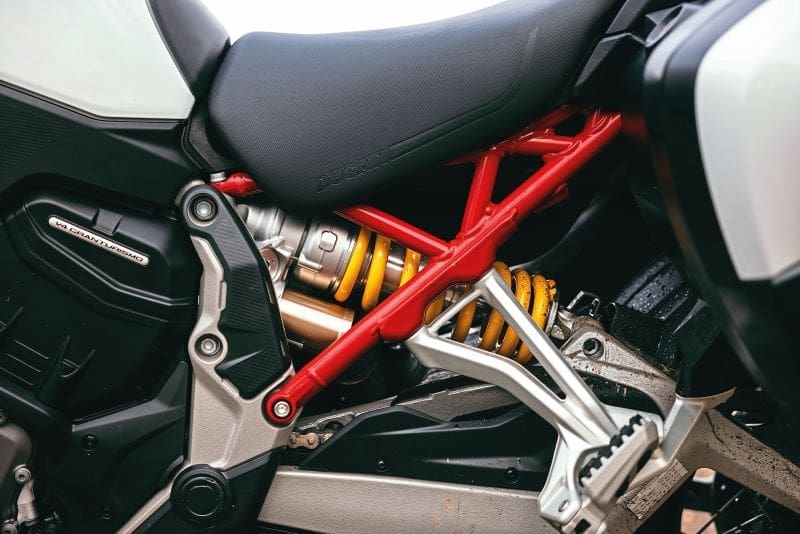
The choice received a bit of criticism – with Multistrada owners of old questioning why you’d mess with a winning formula and compromise road handling by following the crowd and fitting a bigger wheel up front. The good news is that it doesn’t do anything of the sort. It’s still suitably sporty, offering all-round agility and plenty of poise, thanks in part to the ever-brilliant standard fit Pirelli Scorpion Trail II tyres – and it’ll waft over the roughest of surfaces without fuss, too.
The new front wheel and tyre combination also help to improve the Multistrada’s off-road viability. It is still a road bike first and foremost, but it’s far easier to take up lanes than ever before (providing you’ve flicked it into Enduro mode and opted for those spoked wheels from the aftermarket accessories catalogue). The standing position’s decent; nice, neutral and easy to get on with, though I would roll the bars forward and fit some of Ducati’s off-road footpegs to get it just right. I do question how many riders will really want to risk throwing a brand-spanking new £25,000, 243kg motorcycle at the scenery – but credit where credit’s due to whoever does.
It’s comfortable when you’re settled in for long rides, too. The seat’s the right balance of soft and firm; there’s bags of space for my 6ft 1inch frame; and it’s surprisingly quiet thanks to a new easily-adjustable screen and big front fairing combination.
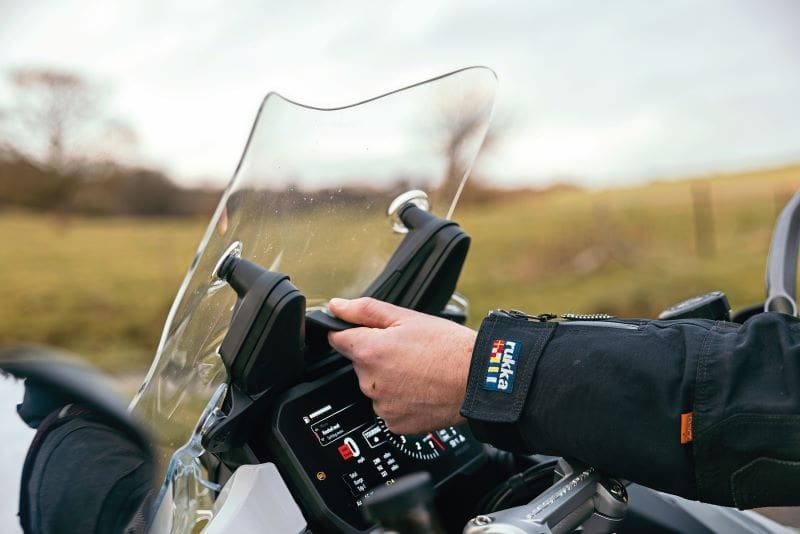
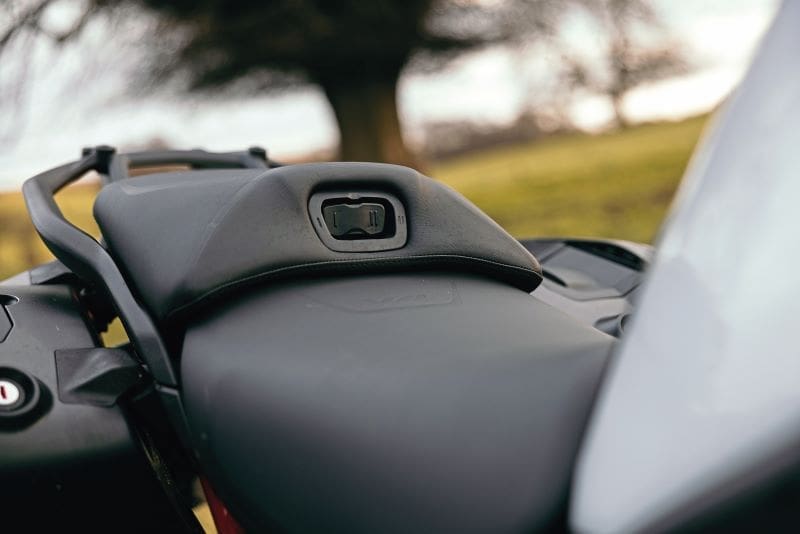
And big miles are the name of the game, after all. That’s why Ducati’s increased the distances you can do between servicing. It needs an oil change every 9000 miles, but will manage 37,000 miles before you have to do any valve clearance work. They’ve also made the bike easier to work on, which should help reduce labour costs when it does eventually have to take a trip to your local dealer for a onceover.
Sadly, it’s not quite so good on fuel as the previous 1260 model. The factory reckons it’ll be good for 43mpg (where the 1260 achieved 54mpg). The good news is that the V4 has a slightly bigger 22-litre tank to help compensate, giving the bike a claimed range of just over 200 miles when brimmed. Even if that’s a real-world 150 miles, most riders will be after a quick pitstop after a couple of hours doing those sorts of distances.
There is an awful lot of competition out there though, with adventurous options to consider from every major manufacturer. At the time of its launch, Ducati did earmark the BMW’s R1250GS as the bike it had in its sights (which means you’ve then got to think about the new R1300GS, Triumph’s Tiger 1200 and KTM’s 1290 Super Adventure). But if you’re exclusively going to be riding on the road, you’d likely also have your eye on something like BMW’s S1000XR, or even Suzuki’s recently-introduced GSX-S1000GX.
Ducati’s Multistrada V4S is an exceptional adventure motorcycle. While BMW’s much-loved GS gets the headlines and sales, the Italian factory’s latest offering is just as good (and in some ways better), in slightly different ways. It’s a super-refined, imminently capable adventure motorcycle that’s very easy to fall in love with. Blisteringly fast and thrilling to ride, it still manages to offer plenty of practicality for proper big-distance riders, all bundled together in a classy, sophisticated and super-stylish package. It’s properly pricey, but if you’ve got 25 grand to splash out on a new bike, I reckon this is one of the best ways you could put it to good use.

EXTRAS
The ‘Full’ pack adds close to £4000 on top of the base £20,495 price tag, and includes the hard panniers, a centre stand, heated grips, a heated seat, the radar system, Akrapovic muffler, and carbon front mudguard.
COMFORT
The plush seat stands at a manageable (for me) 860mm as standard, combining with the low pegs and wide bars to offer proper all-day comfort. The screen provides plenty of protection; and the heated grips and seats make riding all-year round a more pleasant possibility.
TECH
Loaded with the latest goodies, its radars are probably the most exciting addition. There’s a super-effective and surprisingly simple to use radar-assisted cruise control at the front to make it easy to rest your weary hands on big journeys, and there’s a rear radar which’ll let you know if other traffic’s getting a bit too close. Clever stuff.
SUSPENSION
As ever, the ‘strada’s suspension system is seriously good, providing a silky-smooth ride that swallows up potholes while having easy adjustability to get it set just so if you want to firm things up and press on.
MOTOR
A Panigale-derived V4 engine in an adventure bike. You can’t go far wrong. It’s a joy to use, and while it clearly enjoys being worked, a quick flick between rider modes will turn it from rev-hungry beast to docile town potterer.
WHEELS
The new 19-inch front wheel didn’t get much love when it was first revealed. But it works well on the road, and it means you could kit out your ‘standard’ Multi for off-road adventures, instead of splashing the cash on a dedicated Enduro model.
Specification
Ducati Multistrada V4 S
Price: From £20,495 (£25,345 as tested)
Engine: 1158cc V4 Granturismo, V4 – 90°, 4 valves per cylinder, counter-rotating crankshaft, Twin Pulse firing order, liquid cooled
Power: 170hp (125 kW) @ 10,500rpm
Torque: 92lb-ft (125Nm) @ 8750rpm
Frame: Aluminium monocoque frame
Suspension: (F) 50mm fully adjustable USD fork, electronic compression & rebound damping adjustment with Ducati Skyhook Suspension, (R) fully adjustable monoshock, electronic adjustment with Ducati Skyhook Suspension, aluminium double-sided swingarm
Wheels/Tyres: (F) Spoked 3” x 19” / Pirelli Scorpion Trail II 120/70 ZR 19 (R) Spoked 4.5” x 17” / Pirelli Scorpion Trail II 170/60 ZR 17
Brakes: (F) 2 x 330mm semi-floating discs, radially mounted Brembo M50 Stylema monobloc 4-piston 2-pad calipers, radial master cylinder, Cornering ABS, (R) 265mm disc, Brembo 2-piston floating caliper, Cornering ABS
Weight: 243kg (kerb)
Height: 840 mm-860 mm
Fuel tank: 22 litres
Warranty: 24 months / unlimited mileage

